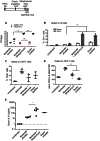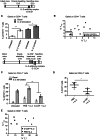The systemic immune state of super-shedder mice is characterized by a unique neutrophil-dependent blunting of TH1 responses
- PMID: 23754944
- PMCID: PMC3675027
- DOI: 10.1371/journal.ppat.1003408
The systemic immune state of super-shedder mice is characterized by a unique neutrophil-dependent blunting of TH1 responses
Abstract
Host-to-host transmission of a pathogen ensures its successful propagation and maintenance within a host population. A striking feature of disease transmission is the heterogeneity in host infectiousness. It has been proposed that within a host population, 20% of the infected hosts, termed super-shedders, are responsible for 80% of disease transmission. However, very little is known about the immune state of these super-shedders. In this study, we used the model organism Salmonella enterica serovar Typhimurium, an important cause of disease in humans and animal hosts, to study the immune state of super-shedders. Compared to moderate shedders, super-shedder mice had an active inflammatory response in both the gastrointestinal tract and the spleen but a dampened T(H)1 response specific to the secondary lymphoid organs. Spleens from super-shedder mice had higher numbers of neutrophils, and a dampened T cell response, characterized by higher levels of regulatory T cells (T(regs)), fewer T-bet(+) (T(H)1) T cells as well as blunted cytokine responsiveness. Administration of the cytokine granulocyte colony stimulating factor (G-CSF) and subsequent neutrophilia was sufficient to induce the super-shedder immune phenotype in moderate-shedder mice. Similar to super-shedders, these G-CSF-treated moderate-shedders had a dampened T(H)1 response with fewer T-bet(+) T cells and a loss of cytokine responsiveness. Additionally, G-CSF treatment inhibited IL-2-mediated TH1 expansion. Finally, depletion of neutrophils led to an increase in the number of T-bet(+) T(H)1 cells and restored their ability to respond to IL-2. Taken together, we demonstrate a novel role for neutrophils in blunting IL-2-mediated proliferation of the TH1 immune response in the spleens of mice that are colonized by high levels of S. Typhimurium in the gastrointestinal tract.
Conflict of interest statement
The authors have declared that no competing interests exist.
Figures







References
-
- Matthews L, McKendrick IJ, Terent H, Gunn GJ, Synge B, et al. (2005) Super-shedding cattle and the transmission dynamics of Escherichia coli O157. Epidemiol Infect 134: 131 doi:10.1017/S0950268805004590 - DOI - PMC - PubMed
-
- Chase-Topping ME, McKendrick IJ, Pearce MC, MacDonald P, Matthews L, et al. (2007) Risk Factors for the Presence of High-Level Shedders of Escherichia coli O157 on Scottish Farms. J Clin Microbiol 45: 1594–1603 doi:10.1128/JCM.01690-06 - DOI - PMC - PubMed
-
- Chase-Topping M, Gally D, Low C, Matthews L, Woolhouse M (2008) Super-shedding and the link between human infection and livestock carriage of Escherichia coli O157. Nat Rev Micro 6: 904–912 doi:10.1038/nrmicro2029 - DOI - PMC - PubMed
-
- Stein RA (2011) Super-spreaders in infectious diseases. Int J Infect Dis 15: e510–e513 doi:10.1016/j.ijid.2010.06.020 - DOI - PMC - PubMed
Publication types
MeSH terms
Substances
Grants and funding
LinkOut - more resources
Full Text Sources
Other Literature Sources
Medical

